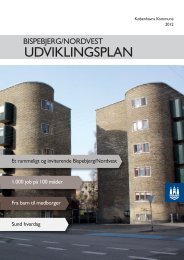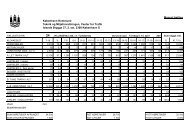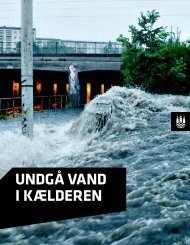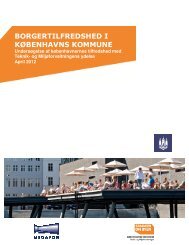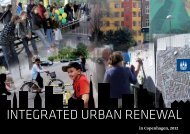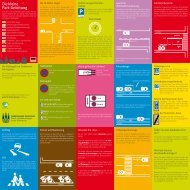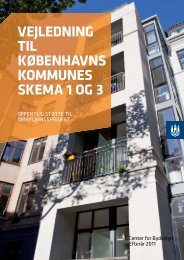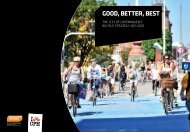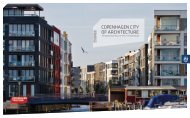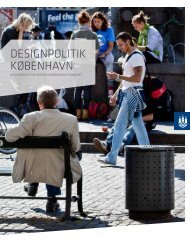SUSTAINABILITY IN CONSTRUCTION AND CIVIL WORKS - Itera
SUSTAINABILITY IN CONSTRUCTION AND CIVIL WORKS - Itera
SUSTAINABILITY IN CONSTRUCTION AND CIVIL WORKS - Itera
Create successful ePaper yourself
Turn your PDF publications into a flip-book with our unique Google optimized e-Paper software.
<strong>SUSTA<strong>IN</strong>ABILITY</strong><br />
<strong>IN</strong> <strong>CONSTRUCTION</strong><br />
<strong>AND</strong> <strong>CIVIL</strong> <strong>WORKS</strong><br />
2010
The Universe, Meinungsgade, Nørrebro, City of Copenhagen, JJW Arkitekter,<br />
Ølgård Consulting Engineers, Contractor The Omega Group, 2009<br />
After School Center is used for community activities and has facilities for playing music<br />
playing sports, and repairing your bike. It “fl oats” in the air in order for the neighbourhood<br />
playground to be retained. It has been designed according to The City of Copenhagen’<br />
guidelines for sustainable construction and civil works.<br />
The building is surrounded by trees; providing shade and cooling in the summer, and allowing<br />
the building to be warmed by the winter sun after defoliation. The construction meets<br />
the requirements of Low Energy Class 1 - the most stringent energy class of the Danish<br />
Building Code. Other sustainable features are a heat exchanger, maximisation of daylight,<br />
energy controlled lighting, and photovoltaics etc.<br />
<strong>SUSTA<strong>IN</strong>ABILITY</strong><br />
<strong>IN</strong> <strong>CONSTRUCTION</strong><br />
<strong>AND</strong> <strong>CIVIL</strong> <strong>WORKS</strong><br />
2010
Table of contents<br />
6 Preface<br />
44<br />
Townscape, City life and Nature<br />
Standards<br />
Documentation<br />
8<br />
12<br />
Introduction<br />
The goal of this booklet<br />
Document guide<br />
Introduction<br />
Standards<br />
Documentation<br />
Sustainable Project Design<br />
Standards<br />
Documentation<br />
54 Waste<br />
Standards<br />
Documentation<br />
62 Noise<br />
Standards<br />
Documentation<br />
68 Indoor Climate<br />
Standards<br />
Documentation<br />
20 Energy and CO 2<br />
Standards<br />
Documentation<br />
76 The Construction Site<br />
Standards<br />
Documentation<br />
28 Materials and Chemicals<br />
Standards<br />
Documentation<br />
34 Water and Drainage<br />
Standards<br />
Documentation<br />
82<br />
Annex<br />
List of legislation and regulations<br />
Links<br />
Illustrations<br />
Adresses<br />
Participants
6<br />
Preface<br />
The City of Copenhagen’s climate plan ambitiously aims to reduce the<br />
city’s CO2 levels by 20 percent by 2015 compared to the levels in 2005.<br />
Copenhagen’s vision is to be CO2-neutral by 2025. If this ambition can<br />
be realised there is a lot of work that needs to be done and therefore<br />
started as soon as possible. Reduction of energy consumption and CO2<br />
emission in the municipalities own or other publically funded building<br />
projects is an important starting point in reaching the set goals.<br />
Copenhagen has ambitious visions and objectives in relation to<br />
sustainability and environmentally friendly construction. Sustainability in<br />
Construction and Civil Works 2010 is an important instrument in<br />
realising these aims.<br />
One of Copenhagen Municipal plan 2009’s main visions is that Copenhagen<br />
should be the “thinking city”, where development and consideration<br />
go hand in hand - sustainability and innovation should be part of the<br />
foundation for Copenhagen’s future development.<br />
in environmental sustainability in the municipal construction and civil<br />
works, including publicly funded and supported projects. In this, the 4 th<br />
generation of Sustainability in Construction and Civil Works, the demands<br />
have been intensifi ed to live up to the ambitious visions for the<br />
cities future.<br />
Bo Asmus Kjeldgaard<br />
Mayor, Technical and Environmetal Administration<br />
Copenhagen has therefore developed the vision laid out in Eco-metropolis.<br />
Copenhagen wants to be the world’s eco-metropolis by 2015 - the<br />
capital city with the best urban environment, thus demonstrating that<br />
environmental concern adds an extra dynamic to urban development.<br />
Eco-metropolis includes a list of specifi c objectives to be fulfi lled by<br />
2015.<br />
Last but not least, is Copenhagen’s vision A Metropolis for people,<br />
which contains specifi c aims related to city life in Copenhagen by 2015.<br />
Copenhagen should be the best city to live in, a sustainable city with<br />
urban spaces that invite a diverse spectrum of users and uses.<br />
Sustainability in Construction and Civil Works 2010 is complimentary to<br />
the above mentioned publications. The new guidelines for sustainable<br />
construction shall help to achieve Copenhagen’s ambitious objectives
8<br />
Introduction<br />
In the development of a sustainable city it is important that use of resources<br />
and the environment are considered, together with the creation<br />
of healthy and good physical environments as parameters for sustainable<br />
construction. This is why the Copenhagen City Council adopted its<br />
fi rst set of guidelines for Sustainability in Construction and Civil Works<br />
2010in 1998. The guidelines have been updated regularly and are<br />
based on the premise that the City of Copenhagen should lead the way<br />
in environmentally sound construction and civil works.<br />
The goal of this booklet<br />
Sustainability in Construction and Civil Works 2010 is intended to promote<br />
a reduction in the impact on the environment – from for example<br />
the use of energy and resources, from waste and noise – in the municipality’s<br />
construction, subsidized construction, urban renewal, and civil<br />
works. The guidelines are also intended to inspire private developers<br />
to focus more on the environment, a healthy indoor climate, and good<br />
urban surroundings. The guidelines can also serve as the basis for<br />
implementing front-line (housing) projects with respect to sustainability<br />
and energy use that can prove exemplary and provide inspiration both<br />
nationally and internationally.<br />
The standards in this booklet are binding for construction, remodelling,<br />
renovation projects, and civil works that involve the City of Copenhagen<br />
as the developer or contractual user and for construction, remodelling,<br />
and renovation projects that are subsidized by the City under regulations<br />
on urban renewal and subsidized building or through municipal<br />
pools. The standards must be incorporated into the terms when tenders<br />
are invited for municipal construction and civil-works projects and when<br />
subsidies are approved for urban renewal and public construction.<br />
The standards are accompanied by prominent examples of how measures<br />
that promote sustainability can be used as an integral part of<br />
architectural design. These examples are intended to serve as a source<br />
of inspiration for those in charge of projects in the City of Copenhagen,<br />
for external consultants, and for private developers.<br />
Document guide<br />
This document is divided into 9 themes, each of which is made up of a<br />
brief introduction and the standards and documentation that have to be<br />
met. The fi rst theme is sustainable project design. This is important for<br />
ensuring that the other themes are incorporated into a project. The other<br />
themes (Chapters 2-9) must be considered on the basis of sustainable<br />
project design.<br />
Introduction<br />
The introduction presents the theme’s main issues and goals.<br />
The standards mainly incorporate functional environmental goals that<br />
can either be descriptive or given numerical form as norms. Standards<br />
can also specify materials, piping and wiring, work processes, etc. to be<br />
defi ned in greater detail that must always be used (or rejected). Calculations<br />
or descriptions, and possibly simulations or subsequent measurements,<br />
must document that these goals have been reached.<br />
This new edition of Sustainability in Construction and Civil Works 2010<br />
thus formulates standards not only for the construction stage, but also<br />
for use, so that the goals of sustainable project design remain in force.<br />
Some of the themes consequently specify standards for a project’s use,<br />
where relevant.<br />
Documentation<br />
Documentation must be presented that the projects design has met the<br />
standards set down in Sustainability in Construction and Civil Works.<br />
The developer or project owners must submit material that can serve as<br />
a basis for evaluating whether a project meets these standards. Work<br />
may not begin on a project before this material is submitted. When political<br />
approval is requested for a project, its description must show that<br />
the standards set down in Sustainability in Construction and Civil Works<br />
2010 have been met. When the project is delivered, or at the latest<br />
when the construction accounts are submitted, documentation must be<br />
submitted that the necessary measures have been carried out.
10<br />
Managing documentation<br />
For the City of Copenhagen’s own projects, the project manager must<br />
ensure that the documentation meets the standards set down in Sustainability<br />
in Construction and Civil Works.<br />
For external projects, for example subsidized construction or urban<br />
renewal, the developer must submit documentation to the City of Copenhagen,<br />
Urban Design Department, that the standards set down in<br />
Sustainability in Construction and Civil Works 2010 have been met.<br />
Collection of examples<br />
The collection of examples contains pictures and a brief description of<br />
initiatives within the different themes, with focus on comprehensive solutions<br />
and the use of measures that promote sustainability as an integral<br />
part of the architecture.
12<br />
Sustainable Project Design
14<br />
Sustainable project design is a work method that is intended<br />
to ensure optimal results for the environment in construction<br />
and civil works. This method is used to map out, evaluate, and<br />
prioritize all significant environmental impacts. Goals are set<br />
for how much environmental improvements are intended to<br />
achieve. In addition, care is taken that the relevant measures<br />
to promote sustainability are used in keeping with these goals.<br />
The aim is environmental quality control, with the environmental<br />
standards and measures used to meet them are carried<br />
through consistently in the project during production/extraction,<br />
construction, use, maintenance, and finally removal.<br />
Sustainable project design is an interdisciplinary method that<br />
is of decisive importance for implementing environmental<br />
considerations in construction and civil works. It is essential<br />
that all parties involved in construction focus on sustainability<br />
at an early stage in the project, and it is also important that<br />
environmental considerations be incorporated into the entire<br />
process.<br />
Sustainable project design comprises a life-cycle perspective<br />
for materials, structures, piping and wiring, and the project as<br />
a whole, from extraction to removal.<br />
Lærkehaven, Lystrup, Denmark, Herzog + Partner, 2008<br />
This residential complex was the result of an international project competition, “Architecture<br />
and sustainability in Danish housing construction,” in 2003. Lærkehaven (50 lowenergy<br />
houses) was designed with an emphasis on high-quality architecture, sustainability,<br />
and the incorporation of environmentally sound products and building techniques from the<br />
site plan to the detailing. The buildings are compact and well-insulated with an average<br />
blower-door test result of 0.8. FCS-certifi ed wood is used for the larch cladding. The windows<br />
on the north have a U-value of 0.66, while others have a U-value of 1.18.<br />
Floor-to-ceiling windows optimize daylight, and there are manual shutters on the east,<br />
south, and west facades. District heating with piping under the buildings minimizes heat<br />
loss. There is LED lighting in kitchens, corridors, and bathrooms. PCM temperature regulating<br />
panels are used in the ceilings. An 80-sq. m. photo-voltaic panel system is installed<br />
on the site. The two-story units are low energy class 1. Rainwater is infi ltrated via french<br />
drains or is channelled to the local stream.
16<br />
Standards<br />
Construction, large-scale remodelling, and civil works must be carried<br />
out through the use of sustainable project design. The design must be<br />
based on the City of Copenhagen’s standards for sustainability in construction<br />
and civil works. These standards are found in Chapters 2-9 of<br />
this booklet.<br />
Sustainable project design must include the following four elements:<br />
within the economic framework. Additional measures are chosen<br />
until the environmental goals are achieved. The higher the priority<br />
an environmental effect has, the more important it is to have it meet<br />
the environmental goals. The list of measures also notes who is<br />
responsible for implementing the individual measure. This might be<br />
the architect, the consulting engineer, the contractor, the developer<br />
himself, etc.<br />
1.<br />
2.<br />
3.<br />
4.<br />
An environmental survey<br />
The impact on the environment by construction or civil-works projects<br />
must be surveyed and evaluated systematically. The evaluation<br />
must be made on the basis of a comprehensive survey of environmental<br />
impacts and their derivative effects on the environment<br />
in conjunction with construction, use, and decomposition.<br />
Environmental priorities<br />
A selection is made of 3-6 impacts on the environment that will be<br />
focus areas in the project, based on their environmental effects and<br />
the developer’s environmental goals. A special effort will be made to<br />
reduce these impacts, which must moreover be prioritized.<br />
Environmental goals<br />
Environmental goals must be formulated for impacts that have been<br />
prioritized in such a way as to be measurable, i.e. so that documentation<br />
can subsequently be provided on whether or not they<br />
have been met. The environmental goals for the project must be<br />
supported by the relevant standards described in the following eight<br />
chapters.<br />
Measures<br />
Based on these environmental goals, a gross list of measures<br />
must be compiled that will contribute to meeting the environmental<br />
goals. When the fi nal decisions are made on choosing measures,<br />
the total economic evaluations (explained below) of the individual<br />
solutions chosen must be taken into account. Measures should<br />
be chosen so as to achieve the greatest environmental advantage<br />
The project’s overall economy must be considered in order to evaluate<br />
its costs and economic gains. This evaluation covers the project’s<br />
economy in the entire process, from procurement, through use, to fi nal<br />
removal. Any evaluation of individual measures is made in comparison<br />
with traditional solutions. Will the measure be more expensive or cheaper<br />
than a traditional solution No precise calculations are made, only<br />
evaluations that will facilitate the selection of measures that will yield<br />
the greatest savings/fewest expenses and at the same time contribute<br />
to meeting goals. This makes it possible to choose a smaller number<br />
of measures that look promising with a view to both sustainability and<br />
the economy and to carry out more precise calculations, for example on<br />
payback times.
18<br />
Documentation<br />
The following documentation is required in conjunction with sustainable<br />
project design:<br />
• Environmental surveys and priorities<br />
• A sustainability program that contains environmental goals<br />
• A list of measures with overall economic evaluations, possibly<br />
including payback times for selected measures<br />
An environmental plan must be drawn up and updated regularly. The<br />
approved measures in the environmental plan must be incorporated into<br />
the project, and the results of the measures that are carried out must<br />
subsequently be documented.<br />
The sustainability status must be determined at the end of the individual<br />
project stages in keeping with the sustainability plan’s guidelines, with<br />
the aim of following up on the environmental plan and the measures that<br />
have been carried out. The results of this status must be documented.<br />
When the project has been completed, a fi nal evaluation must be made<br />
that describes the measures that were incorporated into the project. An<br />
evaluation must also be made of whether the goals were met and of any<br />
divergences from the standards set down in Sustainability in Construction<br />
and Civil Works 2010.
20<br />
Energy and CO 2
22<br />
Producing energy with fossil fuels emits CO2, which<br />
is considered to be a major source of global climate<br />
change. Denmark has committed itself internationally<br />
to reduce its CO2 emissions. The City of Copenhagen<br />
has there over drawn up an ambitious climate plan.<br />
Its goal is to reduce CO2 emissions from energy<br />
production, transport, and waste management by<br />
20% in 2015 from the 2005 level. The City of<br />
Copenhagen also aims to be CO2 neutral in 2025.<br />
Building use consumes considerable energy. This is<br />
why more stringent standards are set for optimizing<br />
energy in new municipal construction and renovation<br />
projects than those found in the Building Code.<br />
The use of energy-efficient supplies and renewable<br />
energy can reduce the use of fossil fuels and thus<br />
CO2 emissions.<br />
Gemeindezentrum in Ludesch; Vorarlberg, Austria, Hermann Kaufmann, 2006<br />
This cultural and community centre was constructed so that it meets the standards for<br />
passive-energy houses. The outer walls and roof were insulated with cellulose/paper (30<br />
cm) and sheep’s wool (10 cm). The building is heated by a pellet furnace, fi red with a<br />
bi-product from the local wood-processing industry. A geothermal system pumps air 35<br />
meters down into the earth, where there is a constant temperature of 7 degrees. The air<br />
is heated in the winter and cooled in the summer and circulated in the building’s heating/<br />
cooling system. Water is heated by a solar-heating unit installed on the roof of the building.<br />
Electricity is supplied from a 350-sq-m. photo voltaic units mounted on the plaza in front of<br />
the building.<br />
Integrated photo voltaic panels on youth flats, Århus, Denmark<br />
The southern façade consists of 84 photo voltaic panels which produces approximately<br />
12 kWh/per year. As well as functioning as a cladding system and electricity producer, the<br />
elements allow air intake with the possibility of preheating the air, when the sun is shining.
24<br />
Standards<br />
Energy consumption in buildings<br />
New construction and expansions must be carried out in keeping with<br />
low-energy class 2015, as set down in the current Building Code.<br />
For major renovation projects, all energy measures that have a payback<br />
time of less than 10 years must be carried out. An evaluation must be<br />
made for measures with a payback time of up to 20 years with a view<br />
to making a concrete decision on implementing them. For local facilities<br />
that produce renewable energy, the payback time may be longer than<br />
20 years, though no longer than the facility’s lifetime.<br />
For renovation projects, existing windows in buildings worthy of preservation<br />
should be retained. The U-value can be improved by for example<br />
adding removable windows or using coupled frames with super thermo<br />
glazing.<br />
The following standards have been set for U-values for new and renovated<br />
windows:<br />
Single-pane windows<br />
• 2-layer pane: U = 1.4 W/sq. m.K. For windows smaller than 1 sq.<br />
m., the U-value may not exceed 1.2 + 0.2/A W/ sq. m.K, where A<br />
is the area of the window. The U-value may not, however, exceed<br />
1.8 W/ sq. m.K.<br />
• 3-layer pane: U = 0.9 W/ sq. m.K. For windows smaller than 1 sq.<br />
m., the U-value may not exceed 0.7 + 0.2/A W/ sq. m.K, where A<br />
is the area of the window. The U-value may not, however, exceed<br />
1.3 W/ sq. m.K.<br />
Four-pane windows<br />
• 2-layer panes or removable/coupled frames with one pane (1+1):<br />
1.7 W/ sq. m.K.<br />
• 3-layer panes or removable/coupled frames with 2-layer super<br />
thermo glazing (1+2): 1.3 W/ sq. m.K.<br />
The glass must not give colour distortion.<br />
Changes to an existing building envelope that are aimed at optimizing<br />
energy use or the installation of systems for renewable energy must harmonize<br />
with the architectural style of the building and its surroundings.<br />
Energy meters (electricity, heat, and water) and energy control should<br />
be used on the one hand to make users aware of their electricity and<br />
heating consumption and on the other to enable effective management.<br />
A remote-reading system (for example CTS) should be installed in all<br />
new buildings and when large buildings undergo thorough renovation.<br />
When ventilation and heating stems are installed or renovated, the systems<br />
must be optimized for energy use so that an effect of at least 85%<br />
is achieved.<br />
Lighting<br />
Lighting with the lowest energy use and the lowest environmental<br />
impact should be used based on an evaluation of what is technically<br />
possible and economically feasible. This applies both to the renewal of<br />
old structures and the building of new ones.<br />
Outdoor lighting instillations should be environmentally friendly light<br />
sources with a high lm/W ratio, i.e. and a high luminous effi cacy in<br />
relation to the light source’s energy use. Incandescent bulbs may not be<br />
used.<br />
Outdoor lighting must be controlled by twilight relays to meet actual<br />
requirements.<br />
Equipment in buildings<br />
Energy use by equipment in buildings (lighting, appliances, standby,<br />
etc.) should be limited as far as possible.<br />
The stipulations found on the website of the Danish Electricity Saving<br />
Trust (www.elsparefonden.dk) must be followed for the installation of household<br />
appliances (refrigerators, freezers, ranges, ovens, fans, washing<br />
machines, etc.).
26<br />
Low-energy washing machines with water-efficient programs should be<br />
used in communal laundries. A user or payment system must moreover<br />
be put in place to ensure that the machines are used optimally.<br />
There must be facilities for line-drying laundry where communal laundries<br />
are installed in new residential buildings.<br />
Existing communal laundries and the option of line-drying laundry<br />
should be retained when buildings are renovated.<br />
Town gas<br />
When urban renewal is carried out, gas piping for cooking and gas ranges<br />
should be retained and/or renovated. It must be possible to use gas<br />
for cooking in all dwellings.<br />
New buildings must be linked up with the town-gas network if the building<br />
is inside or adjacent to the supply area. It must be possible to use<br />
gas for cooking in all dwellings.<br />
In addition, gas must be used in institutional kitchens and for dryers and<br />
mangles installed in communal laundries, institutions, etc.<br />
A dispensation can be granted from using town gas where there is a<br />
documented risk or especially low consumption.<br />
Collective energy supplies<br />
Buildings should as far as possible be connected to the district-heating<br />
network to exploit the effective energy produced by waste incineration<br />
and the use of biomass. Heating facilities should be designed to achieve<br />
the effective cooling of return circulation.<br />
Use<br />
When delivery is made, personnel and other relevant users must be<br />
ensured instruction/training with a view to regular energy optimization.<br />
There must be systematic follow-up of use and settings (times, temperatures,<br />
air volumes, etc.) of heating and ventilations systems and equipment<br />
upon delivery and at the one-year inspection.<br />
Documentation<br />
Documentation on the following is required:<br />
• Documentation that the required low-energy class has been implemented<br />
must be submitted to the City’s project manager at the latest<br />
when the application is submitted to the authorities.<br />
• Documentation that a blower-door test and a thermo photography<br />
analysis have been carried out in new construction projects. In<br />
projects concerning existing buildings documentation should be supplied<br />
to guarantee that the climate shield has been renovated. Both<br />
of these should always be reviewed in conjunction with delivery (and<br />
possibly again after any construction defects are corrected) by an<br />
impartial company approved by the developer. This procedure can<br />
serve as the basis for follow-up and decisions on placing accountability<br />
if defects are found on delivery.<br />
• Documentation must be submitted that the standards set for<br />
U-values have been met.<br />
• For major renovation projects, documentation must be provided on<br />
what possible energy measures have been considered, along with<br />
their payback time, and which measures were carried out. A survey<br />
must be presented of derived CO2 savings in relation to the minimum<br />
standards in the Building Code.<br />
• In new and renovated buildings, meters must be installed that automatically<br />
transfer consumption data to the City’s energy-registration<br />
systems, administered by Copenhagen City Properties.
28<br />
Materials and Chemicals
30<br />
The choice and use of materials in construction<br />
and civil works has a great importance for the<br />
subsequent use and maintenance as well as<br />
for the health of the users and people living in<br />
them.<br />
Construction and civil works are among the<br />
sectors with the highest consumption of raw<br />
materials. Although there is an exceedingly<br />
high level of recycling of materials from the<br />
construction sector in Copenhagen, this largely<br />
involves the recycling of limited, non-renewable<br />
raw materials that also have a negative impact<br />
on the environment when they are extracted,<br />
transported, and processed.<br />
By making a careful choice of materials, proportions,<br />
and structures, the consumption of<br />
resources and the negative impact on the environment<br />
and health can be reduced significantly<br />
in the production and transport of materials,<br />
during the construction stage, everyday use,<br />
maintenance, and finally removal/recycling.<br />
St. Gerolds community house, Vorarlberg, Austria, Cukrowicz Nachbaur<br />
The four storey community house consists of a day-care centre, convenience store, a multipurpose<br />
room, and the mayor’s offi ce. All the buildings structural components are made<br />
of solid wood, wood, mainly from forest owned by the municipality and it is not treated with<br />
any preservation. The compact volume helps keeping the energy consumption very low.<br />
The building is practically self-supplied with energy.
32<br />
Standards<br />
Structures and materials must be chosen that are appropriate for the<br />
building’s expected lifetime, so that there is a limited need for maintenance<br />
and there are good prospects for sustainable use (including<br />
cleaning), and so that the majority of materials can be recycled after<br />
removal.<br />
No building materials or structures may be used that will probably have<br />
to be put into landfi lls after their lifetime if there are other suitable alternatives.<br />
Suitable recycled materials should be used, if of a suffi ciently high<br />
quality, instead of new raw materials, for example brick, concrete, stone,<br />
wood, steel, glass, etc., for, for e.g. filling, stabilizing, surfacing, etc.<br />
No roofi ng or facade panels may be used that is made of metals that<br />
pollute the rainwater above a recipient’s limits (e.g. copper, zinc, etc.)<br />
unless these materials have been given a surface treatment. (The standards<br />
must also be met by gutters and downspouts.)<br />
No products or materials may be used that contain substances on the<br />
list of unwanted substances compiled by the Danish Environmental<br />
Protection Agency or Green Cities’ list of problematic substances (i.e.<br />
brominated fl ame-retardants, chlorinated paraffi n’s, chlorinated solvents,<br />
mineral oil, nonylphenols, phthalates), if suitable alternatives are available.<br />
(See the link at the back of this booklet.)<br />
Eco-labelled (e.g. Dansk Indeklima Mærkning, Nordic Swan, EU Flower)<br />
substances, building materials, and cleaning agents must be used<br />
where possible.<br />
Asphalt products must be chosen that contain bitumen without solvents,<br />
such as fl uxed bitumen or bitumen emulsion.<br />
Materials that pose a high health risk and environmental hazard during<br />
manufacture, use, and removal must not be used.<br />
Use<br />
A Manual must be compiled on the use of materials and methods for<br />
use and maintenance (including cleaning) that will contribute to optimal<br />
sustainable use.<br />
Documentation<br />
The choice of materials, etc. must be specifi ed in the invitation for tenders.<br />
Documentation that the materials described have been used before<br />
must be provided in the quality-control information that the project<br />
manager reviews.<br />
If divergences are made from these standards, reasons for doing so<br />
must be explained in conjunction with the environmental status report<br />
(sustainable project design). This also applies to the choice of structures,<br />
materials, and products for which there are no suitable alternatives<br />
and when materials are used, that currently must be disposed of in a<br />
landfi ll.<br />
The structural protection of wooden structures and surfaces must be<br />
used as far as possible. Heartwood must be used for external structures<br />
if Nordic wood is used, and the wood must not be impregnated.<br />
An FSC certifi cate or corresponding documentation must be provided<br />
when tropical wood is purchased.
34<br />
Water and Drainage
36<br />
It is the City of Copenhagen’s vision not to extract more drinking water<br />
than can be replenished. Water consumption must consequently be<br />
reduced. The goal is for average water consumption in 2012 not to exceed<br />
90 litres per person per day in households and 30 litres per person per<br />
day in business and industry. By planning piping and choosing the right<br />
fixtures and equipment, lower-than-average consumption can be achieved<br />
in new construction and urban-renewal projects.<br />
It is the City of Copenhagen’s overall goal for rainwater to be discharged,<br />
channelled, and/or percolated locally in order to maintain the groundwater<br />
levels and qualities under the City that supplies it with drinking water and<br />
in order to augment the water in lakes and watercourses. (See the City of<br />
Copenhagen’s wastewater plan, 2008.)<br />
Climate changes and stricter environmental standards mean that in the<br />
future, sewers will be too small to accommodate the increased amount of<br />
rain. In order to prevent overloading the drainage system, the discharge of<br />
rainwater into the system must be reduced as much as possible. This will<br />
prevent bodies of water from being polluted by wastewater from stormwater<br />
releases and reduce the load on sewage-treatment plants. The City<br />
of Copenhagen has decided that these problems should be solved locally,<br />
so that rainwater is collected, used, evaporated, percolated, or discharged<br />
where it falls. Strategies of this type are called Sustainable Urban Drainage<br />
Systems SUDS (lokalafledning af regnvand (LAR) in Danish). The strategy<br />
will be used to adapt the City’s discharge of rainwater to future climate<br />
changes as well as current conditions.<br />
Peblinge Dosseringen 24; Copenhagen, Denmark, Byens Tegnestue, 2009<br />
A green roof was used for the fi rst time on an historic multi-storey building in Copenhagen<br />
when a new roof terrace was added to it. There is a tradition in Denmark for using green<br />
roofs, but mostly on single family homes or small buildings. Now the technique has been<br />
developed so that mats are available with different plants. Some mats are so light that<br />
roofs do not need to be reinforced.<br />
Augustenborg; Malmö, Sweden, Malmö Municipality, 2003<br />
3000 residents, 1800 units, 32 ha.<br />
For many years, Augustenborg was plagued by flooded cellars sometimes as often as<br />
ten times a year. When the neighbourhood underwent community regeneration, the new<br />
landscaping included open channels, ditches, retaining pools, reeds and small lakes,<br />
through which rainwater runs, is delayed, collected, percolated, and eventually evaporates.<br />
These water elements and features allow rainwater to be used for recreation. Rainwater<br />
conducted in pipes under the asphalt ball court cools it in the summer and reduces<br />
energy consumption when it is transformed into an ice-hockey ring in the winter. The<br />
amount of rainwater lead to the sewage system has been reduced by 40%.
38<br />
“8-tallet” The figure 8, Orestad South; Copenhagen, Denmark, BIG, 2010<br />
The bowtie-shaped 61,000 m 2 mixed-use building of residential housing and 10,000 m 2<br />
of retail and offi ces comprises Denmark’s largest private development ever undertaken.<br />
Budget EUR 92.000.000.<br />
“8 House is a three-dimensional neighborhood ”. “8 House is our second realized example<br />
of architectural alchemy - the idea that by mixing traditional ingredients, retail, rowhouses<br />
and apartments in untraditional ways - you create added value if not gold. The mix allows<br />
the individual activities to fi nd their way to the most ideal location within the common framework<br />
- the retail facing street, the offi ces towards northern light and the residences with<br />
sun and views to the open spaces. 8 House is a perimeter block that morphs into a knot,<br />
twisting and turning to maximize the life quality of its many inhabitants,” Bjarke Ingels, BIG<br />
A continuous public path stretches from street level to the penthouses and allows people<br />
to bike all the way from the ground floor to the top (10th fl oor), moving alongside townhouses<br />
with gardens, winding through an urban perimeter block. Two sloping green roofs<br />
totaling 1,700 m 2 are strategically placed to reduce the urban heat island effect as well<br />
as providing the visual identity to the project and tying it back to the adjacent farmlands<br />
towards the south.<br />
The roof also helps regulate and delay rainwater fl ow. The rainwater in Orestad which<br />
falls on roofs, facades and terrain is lead to the rural and the urban channels, basins and<br />
lakes, and fi nally ends in the wetlands south of Orestad. These wetlands constitute a large<br />
sanctuary for birds and wildlife.
40<br />
Standards<br />
Drinking water<br />
In new buildings and in existing buildings where water pipes are replaced,<br />
individual water meters must be installed that can promote lower<br />
consumption and make it possible to set up green balance sheets. Individual<br />
water meters must be installed in existing buildings if the number<br />
of water meters can be limited to two per dwelling.<br />
Communal laundries must use low-energy machines with water-saving<br />
programs. A user or payment system must be put in place to motivate<br />
the optimal use of the machines.<br />
Pipes for both cold and hot water must be insulated and separated from<br />
heating pipes in service cores.<br />
Piping must be installed so that leaks are visible and so that no more<br />
than 10 seconds elapse before a hot-water temperature of 55º C. is<br />
reached in the furthest hot-water tap in the building with a fl ow of 0.2 l/s.<br />
This is the best way to avoid wasting water.<br />
Rainwater and drainage<br />
Rainwater must be used to fl ush toilets and in washing machines in<br />
new buildings, though this is not permitted in hospitals, old-age homes,<br />
schools, hotels, or day-care institutions.<br />
Unpolluted rainwater from roofs and impervious areas must be reused<br />
locally or, if possible, discharged into a natural or artifi cial body of water<br />
or percolated, in keeping with the principles laid down for SUDS in the<br />
municipal wastewater plan.<br />
Rainwater that is used or discharged into bodies of water may not contain<br />
pollutant components in excess of the set limits for the recipient.<br />
Polluted water from roads must be treated and discharged into bodies of<br />
water, where possible. Otherwise, this water must be conducted to the<br />
common sewer. The project must be approved by Copenhagen Energy’s<br />
sewerage department.<br />
Special standards for new buildings<br />
For new buildings, the three-pipe system should be implemented as<br />
a possible SUDS principle. In this system, wastewater is conducted<br />
into three different pipes. Roof water must be used in buildings or else<br />
discharged into a natural or artifi cial body of water. Road water must be<br />
channelled into a local treatment unit for treatment before being discharged<br />
into a natural or artifi cial body of water. Gray water is conducted<br />
in a third pipe to the treatment plant.<br />
For new buildings, SUDS standards must be met for all projects with a<br />
total area 300 sq. m. or more. A dispensation can only be granted if local<br />
conditions make it impossible to meet the standards.<br />
Impervious areas must contribute to SUDS.<br />
In urban-renewal or other subsidized projects, video cameras must be<br />
used to inspect the building’s sewer system, to determine any need for<br />
renovation.<br />
Before plastic water and drainage pipes are buried, information must be<br />
obtained from the Environmental Department on whether evidence of<br />
soil pollution has been found.<br />
All indoor feeding pipes must be made of stainless steel. Outdoor pipes<br />
may be made of materials with a corresponding lifetime or longer.<br />
New sewage systems must be dimensioned to take account of reduced<br />
water fl ow with the use of 2/4-liter combination fl ush toilets.<br />
In new buildings, roofs with a slope of 30 degrees or less must be<br />
planted if reasonable conditions exist. When existing buildings are<br />
renovated, roofs must be planted if reasonable conditions exist (Green<br />
Roofs9.
42<br />
The design that is chosen for roof areas must take account of other<br />
requirements for use as well as important technical and architectural<br />
considerations. An overall evaluation must also be made of all project<br />
measures aimed at the reuse of rainwater and sustainable urban rainwater<br />
systems.<br />
Documentation<br />
Drinking water<br />
Water must be incorporated into the green balance sheet, to focus on<br />
the building’s water consumption and allow the individual households to<br />
compare their consumption against the average.<br />
Drainage<br />
In cases where it is not possible to use the SUDS strategy and plant<br />
green roofs, the reasons for this must be documented and an in-depth<br />
study made of the consequences that this will have for the volume of<br />
the discharges and storm-water releases into the recipients. It might be<br />
necessary to delay the water on the property.
44<br />
Townscape, City life and Nature
46<br />
The spaces between buildings and the recreational<br />
areas, such as schoolyards, playgrounds,<br />
squares, plazas, parks, green areas, gardens,<br />
courtyards, gardens, roof tops, lakes, harbours,<br />
and coastal areas, are all of major significance<br />
for the city-dweller’s quality of life and for<br />
people’s understanding of their environment,<br />
and are a valuable resource for Copenhagen.<br />
The townscape must also promote sustainability<br />
by inviting to an exciting and diverse life in the<br />
city.<br />
In urban renewal, renovation projects, and new<br />
construction, focus must be aimed at what the<br />
spaces will be used for, what is needed there,<br />
and how their use harmonizes with their surroundings.<br />
The aim is to optimize the use of<br />
every space.<br />
It is important to develop and protect “green and<br />
blue values” in civil works and take them into<br />
account in the use of these spaces, for the benefit<br />
of Copenhagen’s residents and visitors.<br />
Sømærk, Teglværkshavnen; Copenhagen, Denmark, Vandkunsten, 2008<br />
Sømærk in the South Harbour is one of the fi rst residential projects in Copenhagen that<br />
takes an active approach to the harbour and water as a resource. The complex, with 120<br />
units, consists of six long residential buildings, four of which stand on pillars in the water.<br />
This created three basins/gardens surrounded by jetties from which residents can safely<br />
take a swim. The buildings alternate between condominiums and public housing, but the<br />
residents share the parking and community centre.
48<br />
Ecoboulevard, Madrid, Spain, [ecosistema urbano], 2007<br />
The Ecoboulevard project in Madrid features a number of installations called “air trees,”<br />
which create shady areas that augment the boulevard’s trees until the saplings have<br />
grown big enough to provide shade. These artifi cial trees were designed as temporary<br />
structures that can easily be dismantled and moved elsewhere when they are no longer<br />
needed. The three “air tree” groups create cool outdoor spaces through natural ventilation<br />
by sucking air up through the structure. Photo voltaic units mounted on the roof provide<br />
them with energy. They give the area a distinctive identity and help create an active<br />
social space. When the boulevard’s trees are big enough, the “air trees” can be moved to<br />
another area and the space they had occupied appears to be like clearings in the boulevard’s<br />
forest of trees.
50<br />
Krav<br />
General<br />
Sun, shade, wind, and turbulence must be studied during the planning<br />
stage.<br />
When new buildings are planned and urban renewal is carried out,<br />
recreational facilities must be agreed upon at the same time as the building<br />
project. Decisions must be made at this stage on what green and<br />
blue areas will be incorporated into the project, and it must be ensured<br />
that new facilities harmonize with the City’s overall green and blue structures.<br />
An evaluation of the potential to promote good city life must be made for<br />
every project.<br />
Outdoor, recreational areas and plazas must not be open to vehicular<br />
traffi c or used for parking.<br />
Bicycle racks and small buildings, for example sheds for refuse containers<br />
or bicycles must be integrated into new residential projects.<br />
Lighting must help create a safe and secure everyday environment in<br />
Copenhagen. The standards set down in the City’s strategy for lighting<br />
(www.kk.dk/byenslys) must be met for outdoor lighting in public areas<br />
and other places where the City is responsible for lighting.<br />
Any contaminated soil that poses an environmental or health hazard<br />
must be removed as far as possible.<br />
Where the landscape is altered by civil-works and renovation projects<br />
and where children, especially, can come in contact with the soil afterwards,<br />
the top half meter must consist of documented clean material. If<br />
play areas are designed with little hills, etc. that must withstand heavy<br />
use, they must be covered with one meter of documented clean material.<br />
Nature<br />
Green areas and structures must take into account preserving – and<br />
preferably expanding – the current biodiversity of fl ora and fauna and<br />
ensuring their optimal living and growth conditions. Links must be<br />
created between biotopes in surroundings areas.<br />
Plants should be chosen so that they thrive under the given conditions<br />
and harmonize with the complex. Plans on how they will be cared for in<br />
the future must be incorporated as a parameter, to avoid excessive resource<br />
consumption. A large part of the greenery should be chosen from<br />
among trees and plants that are native to Denmark and suit the area in<br />
question. Plants should be chosen that refl ect nature’s cycle when they<br />
bloom, produce fruit, and change colour, and provide an attractive home<br />
for insects, birds, and other native wildlife.<br />
Trees and plantings that are worthy of preservation are noted down by<br />
the City’s experts. As a general rule, trees worthy of preservation are<br />
those that are more than 20 years old and can live at least 25 years longer.<br />
These trees may not be removed or pruned without permission from<br />
the City of Copenhagen, Parks and Nature Department. Soil around<br />
these trees may not be removed or replaced.<br />
The growth conditions of trees worthy of preservation must be protected.<br />
No digging may be done in the trees’ roots in the area under<br />
their drip zone, i.e. the area covered by the outermost rim of the crown.<br />
The percentage of greenery compared with that of built and paved areas<br />
must as a minimum be maintained – and preferably increased – in the<br />
individual project.<br />
Trees and fl owerbeds must be protected against the harmful effects of<br />
environmentally hazardous substances. Trees and fl owerbeds can be<br />
protected against salting by fi nishing the planting hole with a dense rim.<br />
Earth fi ll and other fi ll materials must be documented as clean.
52<br />
Trees in open soil beds and in closed paved areas must be planted in<br />
keeping with the City of Copenhagen’s guidelines on planting trees.<br />
(The 2006 standards for landscape gardening must be met.)<br />
Use<br />
The City of Copenhagen does not use pesticides (approved by Dogme<br />
2000 – Green Cities).<br />
Weed control is carried out thermally (burning, steam), manually,<br />
mechanically, or by spreading weed-control fabric and wood chips.<br />
The green area/biofactor and biodiversity must as a minimum be maintained<br />
– and preferably increased – in the management and maintenance<br />
of green areas.<br />
The City must approve the articles of landowners’ associations,<br />
courtyard associations, etc. in order to ensure the quality of use and<br />
maintenance.<br />
Documentation<br />
• The consultant and the developer must provide the necessary documentation<br />
that the relevant standards in this chapter have been met.<br />
This documentation must be submitted to the City’s project manager<br />
at the latest when the project design has been drawn up and before<br />
an application has been submitted to the authorities or invitations for<br />
tenders have been sent out.<br />
• Written documentation must be provided on how good growth conditions<br />
will be ensured. As a minimum, the latest revised norms for<br />
landscape gardening must be followed, including the norms for the<br />
size of plant holes and growth zones.
54<br />
Waste
56<br />
The City of Copenhagen wishes to reduce<br />
the impact on the environment among other<br />
things through sustainable waste management.<br />
The City also wants to ensure that its citizens<br />
are satisfied with how it handles waste<br />
management. Preventing unnecessary waste,<br />
recycling, increased sorting and innovative<br />
facilities in the townscape are important elements<br />
in meeting these goals.<br />
The City of Copenhagen’s waste plan for 2012<br />
sets down the goals of future waste management<br />
and the waste-management system<br />
along with initiatives to be taken during the<br />
period covered by the plan. The plan also provides<br />
examples of measures to be taken in<br />
residential areas and what each individual can<br />
do.<br />
For construction waste, see Chapter 9, The<br />
Construction Site. For waste in public areas,<br />
such as squares and parks, see the City of<br />
Copenhagen’s website.<br />
In the City of Copenhagen, 85% of construction waste is reused, 13% is incinerated, and<br />
2% is land fi lled. Concrete is crushed and reused as aggregate for making new concrete<br />
or for road foundations, metals are separated and melted. Waste incineration supplies the<br />
city with 54% of its district heating. In addition, 13% of the city’s electricity is provided by<br />
refuse incineration, biomass, and biogas.
58<br />
Standards<br />
Households<br />
The necessary space must be set aside so that household waste can be<br />
sorted into a minimum of the following fractions:<br />
• Food waste<br />
• Paper (newspapers, direct advertising material, magazines, etc.)<br />
• Cardboard<br />
• Batteries<br />
• Glass (bottles, jars, etc.)<br />
• Garden waste<br />
• Plastic packaging<br />
• Metal<br />
• Hazardous waste (leftover paint, etc.)<br />
• Bulky waste (PVC, impregnated wood, electronic equipment,<br />
• refrigerator/freezers, and other mixed bulky waste)<br />
Bins for food waste must be placed inside buildings and paper must be<br />
collected in close proximity to residential stairwells. It would be most<br />
effi cient to collect cardboard and batteries in the same place. The other<br />
fractions can best be collected for several buildings at a site within<br />
walking distance of all of them. Fractions that are not covered by the<br />
bulky-waste system, such as plastic, metal, and construction waste, can<br />
be transported from a common collection site to the waste station by the<br />
person responsible for waste management/janitor.<br />
For hygienic reasons, the collection site for food waste should be placed<br />
further than fi ve meters from windows on residential rooms or kitchens<br />
and should be located in the shade.<br />
As a rule, 1/2 sq. m. per unit should be set aside for bulky waste, but an<br />
evaluation must be made each time, depending on the number of units,<br />
the condition of the site, etc.<br />
Alternatives can be found, for example mobile suction, in small courtyards<br />
where special attention must be paid to recreational facilities or<br />
the work environment.<br />
It must be possible to compost garden waste from recreational areas.<br />
Space must consequently be set aside for the purpose.<br />
Use<br />
Users must be given good and logical information on waste management.<br />
This can be provided by the janitor or another person responsible<br />
for waste management or through printed information and signs. Information<br />
can be obtained free of charge from the Environmental Department,<br />
either in person or by ordering it on the department’s website.<br />
(See the link at the back of this booklet.)<br />
Residents must be able to recycle directly and minimize waste at a<br />
“trading post” in the area set aside for bulky waste or e.g. using special<br />
shelves for recycling items.<br />
Commercial and construction waste<br />
Commercial waste must be sorted into all recyclable fractions, hazardous<br />
waste, incinerable waste, and waste to be land fi lled.<br />
Permission must be obtained from the Environmental Department to<br />
recycle slightly contaminated surplus soil from a project on a building’s<br />
own site. Clean surplus soil must be used in recycling before slightly<br />
contaminated soil.<br />
The Environmental Department can require that special types of waste<br />
(e.g. slag from incineration) be recycled in large civil-works projects if<br />
use can take place under environmentally acceptable conditions.<br />
Stone material must be crushed and reused on the site to the extent<br />
that the Environmental Department determines that this is acceptable<br />
considering the surroundings. Permission to do so will be granted by the<br />
Environmental Department.<br />
The developer must ensure that the contractor sorts and minimizes the<br />
amount of construction waste and discarded materials through planning,<br />
building management, logistics, supervision, and quality control.
60<br />
Buildings that have been demolished or renovated must be registered<br />
and a report compiled that confi rms that environmentally hazardous<br />
materials and substances were sorted correctly. This registration must<br />
also cover waste that is directly recyclable.<br />
Documentation must be provided for all forms of demolition work in<br />
accordance with the standards set by the demolition industry’s control<br />
system in 1996.<br />
All materials from construction or civil-works projects that involve<br />
demolition must be sorted and recycled as far as possible.<br />
Optimal management and sorting of waste from construction and<br />
civil-works projects can be ensured by setting up a specifi c contract to<br />
manage waste and impacts on the environment.<br />
Documentation<br />
Documentation must be submitted along with the application to the<br />
authorities that the necessary space has been set aside for waste and<br />
that there is unimpeded access to permit waste to be collected without<br />
diffi culty.<br />
As noted above, the rule of thumb is for 1/2 sq. m. per unit to be set<br />
aside for bulky waste. The dimensions for bins for e.g. food waste and<br />
paper are found on the Environmental Department’s website.<br />
The waste solutions in buildings and housing close to a recycling waste<br />
station can be dimensioned differently. It must, however, be possible to<br />
reinstate the full sorting of all waste.<br />
The environmental report and registration material must be submitted to<br />
the Environmental Department for approval.<br />
Documentation must be submitted to the Environmental Department<br />
that the layout of the building site and organization of waste management<br />
ensure the optimal handling and sorting of waste from construction<br />
and civil-works projects.
62<br />
Noise
64<br />
Noise has a significant influence on our<br />
quality of life and our health. A leading<br />
goal of the City of Copenhagen is to reduce<br />
noise hazards as far as possible.<br />
External noise must be taken into consideration<br />
early in the planning stage.<br />
For new construction, renovation projects,<br />
recreational areas, and in the conversion<br />
of existing buildings to other<br />
uses, care must be taken that buildings<br />
are located, organized, laid out, and<br />
constructed so that residents and users<br />
are protected against external noise<br />
from traffic and commercial activities.<br />
The noise that arises from construction<br />
and civil-works projects must also be<br />
kept at a minimum.<br />
Musée de Quai Branly, Paris, France, Jean Nouvel, 2006<br />
Access to the Musée de Quai Branly is through a park that runs under the museum and<br />
up its facades, and thus becomes an integral part of the architecture. Jean Nouvel’s transparent<br />
baffl e wall forms the border between the Musée de Quai Branly’s park and its bustling<br />
surroundings. The baffl e wall provides a view of the park, so that it can be enjoyed by<br />
passers-by, but also shields it from traffi c noise from the street.
66<br />
Standards<br />
In principle, when areas are converted for a new use and when new<br />
areas are incorporated into the urban space, functions sensitive to noise<br />
(housing, day-care institutions, schools, hospitals, recreational facilities,<br />
etc.) may not be placed in areas where the noise level is currently or<br />
is expected to exceed Lden58 dB from road traffic and Lden64 dB from<br />
railway traffi c.<br />
For public and private administration, the professions, etc. the noise<br />
may not exceed Lden63 dB from road traffi c and Lden69 dB for railway<br />
traffi c.<br />
In new construction areas where the outdoor noise level will exceed<br />
these values, construction for functions sensitive to noise (housing etc)<br />
are permitted with a noise level up to Lden68 dB from road traffi c, Care<br />
must be taken that buildings will be sited, noise walls be built, insulation<br />
be installed, units be designed, etc. to ensure that the indoor noise level<br />
from road traffi c when the windows are open (0.35 sq. m.) does not exceed<br />
Lden46 dB in furnished bedrooms and living rooms. The corresponding<br />
level for noise from railways is Lden52 dB. All bedrooms and living<br />
rooms must have windows that can be opened yet meet these requirements<br />
at the same time. For urban-renewal and renovation projects in<br />
areas where the outdoor noise level will exceed these values and where<br />
it is deemed necessary, care must be taken that the indoor noise level<br />
meets these standards.<br />
For infi ll, however, housing may be built where noise from traffi c is up<br />
to Lden73 dB. It must, however, be possible to keep within these limits in<br />
outdoor recreational areas and indoors with partly open windows.<br />
Institutions, schools, etc. must be built with secondary rooms along<br />
roads with heavy traffi c, and their facades along these roads must be<br />
designed in such a way as to ensure that the indoor noise level with<br />
partly open windows is at most Lden46 dB. The limit applies to facades<br />
with teaching rooms, libraries, wards, etc. For outdoor areas, the limit<br />
of Lden58 dB is in force for schoolyards, playgrounds, etc. Higher noise<br />
levels are acceptable for football fi elds.<br />
The corresponding standards for indoor noise levels with open windows<br />
in offi ces and hotels are Lden51 dB from road traffi c and Lden57 dB for<br />
railway traffi c. For offi ces, an assessment must be made of the necessity<br />
of having windows that can be opened or whether the necessary<br />
ventilation can be provided in other ways.<br />
New traffi c facilities must be located, designed, and if necessary screened<br />
off by noise walls so that the above standards can be met for<br />
buildings that are sensitive to noise and for recreational areas.<br />
Dokumentation<br />
In conjunction with the work of drawing up local plans and specifi c construction<br />
applications, the Environmental Department can itself assess<br />
the noise level, require that the developer make calculations, order the<br />
developer to take specifi c measurements and in special cases require<br />
that the developer carry out subsequent measurements, and calculations<br />
when the project is completed.<br />
The noise level in outdoor recreational areas must not exceed Lden58 dB<br />
from road traffi c and Lden64 dB from railway traffi c. For housing with one<br />
or more outdoor recreational area directly adjacent to the unit, such as<br />
balconies, atria, terraces, etc., at least one of them may not exceed the<br />
limit value of Lden58 dB. Balconies with high noise levels are not taken<br />
into account in calculating recreational areas.
68<br />
Indoor Climate
70<br />
The indoor climate has a major impact<br />
on health and wellbeing because<br />
we spend much of our time indoors,<br />
at home and at work. The quality of<br />
our indoor climates depends on a variety<br />
of factors such as dust, gasses,<br />
noise, temperature, moisture, and<br />
light, which affect people differently,<br />
depending on their individual sensitivity.<br />
The indoor climate must consequently<br />
be given high priority in the<br />
design process and be evaluated considering<br />
the building’s specific use.<br />
Arkitema Head office, Aarhus, Denmark, Arkitema, 2003<br />
The Arkitema building uses natural ventilation. Air comes in and is let out through openings<br />
in the roof. There is a mechanical backup system, which apparently has not yet<br />
been necessary. The advantage of taking the indoor climate into consideration from the<br />
beginning – and especially using natural ventilation – is that higher ceilings and better<br />
daylight are more feasible since the lowered ceilings and pipes required for mechanical<br />
ventilation are not needed. In addition, the roof can be used much better for a terrace, etc.<br />
when it is not cluttered with ventilation units.<br />
Materials and acoustics were also taken into consideration. The fl oors in all transit areas<br />
are glazed concrete, while in the open working areas are covered with wooden blocks on<br />
end that muffl e the sound of footsteps. The ceilings are wood wool/cement boards that<br />
hide an acoustic dampening system. The large atrium has a continuous acoustic dampening<br />
wall; a pressure chamber and acoustic cloth behind an upright plank wall. All these<br />
elements help dampen the hard sounds that are normally found in large areas with glass<br />
and concrete, making it possible for everyone to work and move around in the “same”<br />
space.
72<br />
Standards<br />
Since the indoor climate is given high priority in housing, day-care institutions,<br />
schools, etc., standards must be set for the relevant parameters<br />
for the indoor climate as part of sustainable project design. They can<br />
be based on the Danish Standards’ class values for the indoor climate’s<br />
qualities.<br />
The following aspects must be reviewed and evaluated as part of<br />
sustainable project design:<br />
• Orientation and layout<br />
• Light, daylight, artifi cial lighting, glare<br />
• Choice of materials, degassing, surfaces, colours<br />
• Air quality, natural air exchange, and mechanical ventilation<br />
• Sound, acoustics, noise<br />
• The thermal indoor climate, type of heating, draft, thermal bridges,<br />
and chill (documented with thermo photography)<br />
• Structures, air-tightness, radon<br />
The following class values must not be exceeded:<br />
• The CO2 concentration must not exceed 700 ppm in housing,<br />
1000 ppm in institutions, and 800 ppm in offi ces.<br />
• Calculations of temperature conditions should show that the temperature<br />
is XºC +/- Y/ZºC. The operative temperature (ºC) in housing<br />
and offi ces must be 24.5 +/- 1.0 (summer) and 22.0 +/-1.0 (winter).<br />
• Radon must not exceed 50 Bq/m 3 in housing, institutions, and<br />
offi ces.<br />
• Formaldehyde must not exceed 0.15 mg/m 3 .<br />
• Wood-fi red stoves may not be installed in living quarters because of<br />
particle pollution.<br />
• Daylight must cover at least 11-20% of the glass area/fl oor space.<br />
Daylight must be >3% of the glass area/fl oor space of the workspace<br />
in large and complex rooms.<br />
• Daylight must be provided for work and lounge areas, and suitable<br />
luminance conditions documented by calculating the daylight factor<br />
greater than 2.0 DF.<br />
• The acoustics should at a minimum meet the standards in the Building<br />
Code. The reverberation time in classrooms and day-care institutions<br />
must be 0.4 seconds. The reverberation time in one-person<br />
cell offi ces must be 0.5 seconds. The absorption area in open-plan<br />
offi ces must be 1.1 x the fl oor space.<br />
There must be individually adjustable thermostat-based temperature<br />
control of heating sources.<br />
In new construction, soil or groundwater contamination must not give<br />
rise to problems with the indoor climate.<br />
Potential problems with the indoor climate caused by underground contamination<br />
may as a rule not be alleviated through technical measures<br />
(membranes, ventilated drain pipes, or elevation on pillars). The contamination<br />
must be removed.<br />
Materials and surfaces must be chosen so that they can be cleaned with<br />
agents and methods that do not have a negative impact on the indoor<br />
climate. They may not, for example, lower air quality.<br />
Paint types and other surface treatment must be chosen that will give off<br />
the least possible amount of gas during the building’s lifetime. Surface<br />
treatment must be diffusion-open and the MAL code must not exceed<br />
00-1. A slightly higher MAL code may, however, be necessary with a<br />
view to durability or when restoration/renovation is carried out.<br />
When new furnishings and equipment (TV, IT equipment, photocopiers,<br />
etc.) are purchased, special focus should be aimed at their effects on<br />
the indoor climate. Eco-labelled materials and cleaning agents or products<br />
that meet the same standards must be used.
74<br />
Documentation<br />
The above factors – orientation, light, choice of materials, air quality,<br />
thermal indoor climate, etc. – must be incorporated into sustainable<br />
project design and documented through it and in the form of the project<br />
description and drawings.
76<br />
Construction Site
78<br />
The construction and civil-works stage accounts<br />
for an important part of a project’s<br />
total energy use and can result in a number<br />
of nuisances and inconveniences for<br />
the surroundings. Efforts should consequently<br />
be made to limit the use of energy<br />
and resources, decrease the amount of<br />
building waste, and minimize the nuisance<br />
from noise, vibration, and dust on and from<br />
the construction site. The environmentally<br />
sound management of construction sites<br />
can lead to significant environmental<br />
gains.<br />
Specific standards must be set for the construction<br />
site in tender material for a given<br />
project. The developer’s incentive for incorporating<br />
sustainable measures on the<br />
construction site is lower costs due to<br />
lower consumption.<br />
London Olympics 2012<br />
A building site creates a lot of waste/debris from demolishing, especially from a site of this<br />
magnitude. It has therefore been decided to recycle these materials. Another part of the<br />
Olympic project is the participation and involvement of the local community. Not only in the<br />
design itself, in creating jobs for the members of community, but especially with emphasis<br />
on how the area (quite a poor area) can benefit from this event in the years to come, from<br />
the housing for the athletes, parks, playgrounds, sports facilities , infrastructure and the<br />
event itself.
80<br />
Standards<br />
Planning construction<br />
The developer must, in collaboration with the consultant and contractor,<br />
use construction-site planning and the choice of work methods, machinery,<br />
and the organization of the construction site to ensure that the<br />
surroundings are bothered as little as possible by noise, vibration, air<br />
pollution, dust, and odours from the construction site.<br />
The contractor must be encouraged to minimize transport to and from<br />
the construction site.<br />
The developer must give written notifi cation to the surrounding households,<br />
institutions, etc. about the project’s purpose, character, and time<br />
horizon. A proper information strategy must be devised for major and<br />
protracted construction/renovation projects that will ensure that contact<br />
with neighbours is made in advance and maintained throughout the<br />
construction and civil-works stages.<br />
All construction and civil-works projects that produce noise and dust<br />
must be notifi ed to the Environmental Department at least 14 days before<br />
commencement. See:<br />
http://www.kk.dk/Erhverv/LoveOgRegler/ForsyningOgMiljoe/-edia/4ACB096AC7474EC3A<br />
A03669F7E6403.ashx<br />
Noisy construction and civil-works projects may only be carried out on<br />
weekdays between 7 a.m. and 6 p.m. The Environmental Department<br />
can, in special cases, grant a dispensation for work outside this time<br />
period when construction and civil-works projects cannot be carried out<br />
within this time frame for reasons of safety, traffi c conditions, or technical<br />
considerations.<br />
Safeguarding against pollution<br />
Diesel-powered vehicles weighing over 3.5 tons must be outfi tted with<br />
certifi ed particulate fi lters. Work machines with an effect of over 75 kW<br />
must be outfi tted with fi lters of the same effi ciency. Vehicles with motors<br />
approved in keeping with the Euro IV or Euro V standard are exempted<br />
from this requirement.<br />
The current guidelines, instructions, and permits from the Environmental<br />
Department must be followed in handling soil and groundwater in construction<br />
and civil-works projects.<br />
Protecting plantings<br />
Fencing around the construction site must be at a distance from tree<br />
trunks that corresponds to the size of the crown when trees stand in a<br />
soil bed.<br />
Space that will be used for green areas must be protected e.g. by setting<br />
aside construction, work, and protection zones so that the natural<br />
permeability and structure of the mulch are retained.<br />
Growth conditions must be ensured by watering during the construction<br />
period.<br />
Documentation<br />
For construction and civil-works projects, the developer, in collaboration<br />
with the contractor, must provide documentation on the following in<br />
construction-site plans:<br />
• How transport, energy use, and pollution can be minimized when<br />
materials and soil are conveyed to and from the site<br />
• How the use of energy, water, and fuels can be reduced<br />
• What information strategy has been chosen<br />
The developer must document how planting worthy of preservation will<br />
be protected during the construction period.<br />
The developer must be aware that the documentation – i.e. all of the<br />
points listed above – can be written into the project’s invitation for<br />
tenders as competition parameters.
82<br />
List of legislation and regulations<br />
Lov om byfornyelse og udvikling af byer, lov nr. 1234 af 27-12-2003 med<br />
senere ændringer, lovb. 523 af 06-06-2007, lovb. 436 af 29-05-2008 og<br />
lovb. af 09-09-2008<br />
Lov om almene boliger m.v., lovb. 1000 af 09-10-2008<br />
Lov om ældreboliger, lovb. 907 af 26-09-2005<br />
Lov om miljøbeskyttelse, lovb. 1757 af 22-12-2006<br />
Byggelov, lovb. 452 af 24-06-1998<br />
Lov om planlægning, lovb. 1027 af 20-10-2008<br />
Lov om forurenet jord, lovb. 282 af 22-03-2007<br />
Jordfl ytningsbekendtgørelsen nr. 1479 af 12-12-2007<br />
(Bekendtgørelse om anmeldelse og dokumentation i forbindelse med fl ytning af jord)<br />
Affaldsbekendtgørelsen nr. 1634 af 13-12-2006<br />
(Bekendtgørelse om affald)<br />
Genanvendelsesbekendtgørelsen nr. 1480 af 12-12-2007<br />
(Bekendtgørelse om genanvendelse af restprodukter og jord til bygge- og anlægsarbejder)<br />
Lov om bygningsfredning og bevaring af bygninger, lovb. 1088 af<br />
29-08-2007<br />
Lov om fremme af energibesparelser i bygninger, lov nr. 585 af<br />
24-06-2005<br />
Kvalitetssikring af byggearbejder, lovb. 169 af 15-03-2004<br />
Lov om afgift af affald og råstoffer, lovb. 1165 af 27-11-2006<br />
Lov om CO 2 -kvoter, lovb. 348 af 09-05-2008<br />
Lov om betalingsregler for spildevandsanlæg, lovb. 281 af 22-03-2007<br />
Lov om vandkvalitet og tilsyn med vandforsyningsanlæg, lovb. 1449 af<br />
11-12-2007<br />
Lov om individuel måling af el, gas, vand og varme, lovb. 565 af<br />
01-07-1997<br />
Varmeforsyningsloven, cirkulære nr. 5020 af 30-11-1988<br />
www.retsinfo.dk<br />
Bygningsreglement BR08<br />
www.ebst.dk/bygningsreglement<br />
SBI-anvisning nr. 216 – anvisning om bygningsreglement 2008<br />
SBI-anvisning nr. 196 – Indeklimahåndbogen<br />
SBI-anvisning nr. 219 – Dagslys i rum og bygninger<br />
www.sbi.dk<br />
Normer og vejledninger for anlægsgartnerarbejde 2005<br />
www.danskeanlaegsgartnere.dk<br />
Affaldsdirektiv 2008 (EU-direktiv)<br />
Regeringens affaldsstrategi 2009-2012 1. del af 19-11-2008<br />
Gasreglementet 2005, Sikringsstyrelsen<br />
www.sik.dk<br />
Regulativ for husholdningsaffald, senest revideret 30-11-2006<br />
www.kk.dk/affald<br />
Regulativ for erhvervsaffald, senest revideret 25-05-2000<br />
www.kk.dk/affald
84<br />
Links<br />
Regulativ for forurenet jord i København 01-04-2008<br />
www.kk.dk/erhvervsaffald<br />
Bestemmelser for levering af vandforsyning fra Københavns<br />
Vandforsyning 01-01-2007<br />
www.ke.dk<br />
Arbejdstilsynets At vejledning D.2.24 om indretning og brug af<br />
dagrenovationssystemer<br />
Arbejdstilsynets anvisning af implementering af støjstrategien ved<br />
bygge- og anlægsopgaver<br />
www.at.dk<br />
Vejledning i håndtering af forurenet jord på Sjælland, juli 2001 med<br />
senere ændringer<br />
Miljøstyrelsens Vejledning nr. 5/1984 Tabel I-III (ekstern støj)<br />
Vejstøjsvejledning nr. 4/2007<br />
(støjdæmpende asfalt, nedsættelse af farten og støjisolerende vinduer)<br />
Tropisk træ – miljøvejledning 2003, Skov- og Naturstyrelsen<br />
Miljøstyrelsens skrivelse af 27. marts 1990 om anvendelse af rent,<br />
sorteret bygningsaffald til bygge- og anlægsformål<br />
Anvendelse af opbrudt asfalt til vejbygningsformål m.v.<br />
Cirkulæreskrivelse af 15-07-1985<br />
(genanvendelsesbekendtgørelsen)<br />
Sustainability in Construction and Civil Works 2010<br />
www.kk.dk/MBA2010<br />
Environmental management<br />
Standards and regulations for various environmental aspects like<br />
construction sites, restaurant, cooling and ventilation plants etc.<br />
www.kk.dk.miljoehaandtering<br />
Green Cities’ list of problematic substances<br />
www.dogme2000.dk<br />
Sustainable Urban Drainage Systems (SUDS)<br />
SUDS methods and solutions<br />
www.kk.dk/lar<br />
Lightning in the city<br />
www.kk.dk/byenslys<br />
New projects by the City<br />
www.kk.dk/borger/byog trafi k/anlaegsprojekter.aspx<br />
Waste<br />
www.kk.dk/affald<br />
The construction site<br />
www.kk.dk/byggeplads<br />
Sustainable Construction<br />
www.danskbyokologi.dk<br />
Dansk Standard<br />
www.ds.dk<br />
Sustainable Cities<br />
www.sustainablecities.dk
86<br />
Illustrations<br />
The samples has been collected by Centre of Industrial Architecture<br />
and the City of Copenhagen, Urban Design Department, Environmental<br />
Department and Parks and Nature Department<br />
page<br />
site<br />
photographer/copyright<br />
page site photographer/copyright<br />
Front-page<br />
Universet (the Universe),<br />
Meinungsgade<br />
Copenhagen, Denmark<br />
12-13 og 15 Lystrup<br />
Aarhus, Denmark<br />
20-21<br />
Silkeborgvej<br />
Aarhus, Denmark<br />
JJW Arkitekter<br />
Jens V. Nielsen<br />
Jens V. Nielsen<br />
44-45 og 47 Teglværkshavnen<br />
Copenhagen, Denmark<br />
49 Ecoboulevard,<br />
Madrid, Spain<br />
54-55 og 57 Margretheholm (demolition),<br />
Amagerforbrændingen,<br />
Copenhagen, Denmark<br />
Tøger Nis Thomsen og<br />
City of Copenhagen<br />
[ecosistema urbano]<br />
City of Copenhagen<br />
23 Ludesch<br />
Vorarlberg, Austria<br />
Bruno Klomfar<br />
62-63 og 65<br />
Quai Branly<br />
Paris, France<br />
Centre of Industrial<br />
Architecture<br />
28-29 og 31 Vorarlberg<br />
Austria<br />
Gustavo Ribeiro<br />
68-69 og 71 Arkitema offi ce<br />
Aarhus, Denmark<br />
Arkitema<br />
34-35 Augustenborg<br />
Malmö, Sweden<br />
Jan Burgdorf Nielsen<br />
76-77 og 79 Olympic Stadium<br />
London, England<br />
London 2012<br />
37 Peblinge Dosseringen 24<br />
Copenhagen, Denmark<br />
Jens Harild<br />
39 The fi gure 8<br />
Orestad South,<br />
Copenhagen, Denmark<br />
BIG<br />
Jens Lindhe
88<br />
Adresses<br />
Urban Design Department<br />
Njalsgade 13-15<br />
DK-2300 Copenhagen S<br />
Postadresse:<br />
P.O.Box 447<br />
DK-1505 Copenhagen V<br />
Tlf.: +45 33 66 35 00<br />
bydesign@tmf.kk.dk<br />
www.kk.dk<br />
Environmental Department<br />
Njalsgade 13-15<br />
DK-2300 Copenhagen S<br />
Postadress:<br />
P.O.Box 259<br />
DK-1502 Copenhagen V<br />
Tlf.: +45 33 66 58 00<br />
miljoe@tmf.kk.dk<br />
www.kk.dk<br />
Parks and Nature Department<br />
Njalsgade 13-15<br />
DK-2300 Copenhagen S<br />
Postadress:<br />
P.O.Box 449<br />
DK-1505 Copenhagen V<br />
Tlf.: +45 33 66 36 60<br />
parkognatur@tmf.kk.dk<br />
www.kk.dk<br />
Construction and Tenders<br />
Department<br />
Islands Brygge 37, 3. sal<br />
2300 Copenhagen S<br />
Postadress:<br />
P.O.Box 441<br />
DK-1505 Copenhagen V<br />
Tlf. +45 33 66 35 11<br />
anlaeg@tmf.kk.dk<br />
www.kk.dk<br />
Building Department<br />
Njalsgade 13-15<br />
DK-2300 Copenhagen S<br />
Postadress:<br />
P.O.Box 416<br />
DK-1504 Copenhagen V<br />
Tlf. +45 33 66 52 00<br />
byggeri@tmf.kk.dk<br />
www.kk.dk<br />
Copenhagen City Properties<br />
Nyropsgade 1<br />
DK-1602 Copenhagen V<br />
Tlf.: +45 33 66 6600<br />
Fax: +45 33 66 71 72<br />
kejd@kff.kk.dk<br />
www.kejd.dk<br />
Copenhagens Energy<br />
Ørestads Boulevard 35<br />
DK-2300 Copenhagen S<br />
Tlf.: +45 33 95 33 95<br />
www.ke.dk<br />
Minestry of Environment<br />
Højbro Plads 4<br />
DK-1200 Copenhagen K<br />
Tlf.: +45 72 54 60 00<br />
mim@mim.dk<br />
www.mim.dk
90<br />
Participants<br />
Steering group<br />
Kim Spiegelberg Stelzer<br />
Project owner, Urban Design Department, The Technical and Environmental Administration<br />
Niels-Arne Jensen<br />
Copenhagen City Properties, Culture and Leisure Department<br />
Dorte Skov<br />
Construction and Tenders Department, The Technical and Environmental Administration<br />
Charlotte Korsgaard-Pedersen<br />
Environmental Department, The Technical and Environmental Administration<br />
Project group<br />
Gustavo Ribeiro<br />
Project leader, Urban Design Department, The Technical and Environmental Administration<br />
Tøger Nis Thomsen<br />
Contact on Sustainable Construction and Civil Works 2010, Environmental Department,<br />
The Technical and Environmental Administration<br />
Peter Kærhus Sørensen<br />
Urban Design Department, The Technical and Environmental Administration<br />
Peter Andreasen<br />
Parks and Nature Department, The Technical and Environmental Administration<br />
Michaela Brüel<br />
Urban Design Department, The Technical and Environmental Administration<br />
Jan Burgdorf Nielsen<br />
Parks and Nature Department, The Technical and Environmental Administration<br />
Christina B. Daél<br />
Building Department, The Technical and Environmental Administration<br />
Ole Henriksen<br />
Copenhagen City Properties, Culture and Leisure Department<br />
Maria Miret<br />
Urban Design Department, The Technical and Environmental Administration<br />
Lars Møller<br />
Urban Design Department, The Technical and Environmental Administration<br />
Dorte Rømø<br />
Parks and Nature Department, The Technical and Environmental Administration<br />
Annette Sønderby Jensen<br />
Parks and Nature Department, The Technical and Environmental Administration<br />
Dorte Stender<br />
Construction and Tenders Department, The Technical and Environmental Administration<br />
Merete Strøbech<br />
Parks and Nature Department, The Technical and Environmental Administration<br />
Claus Wilhelmsen<br />
Environmental Department, The Technical and Environmental Administration<br />
Layout<br />
Signe Birkedal Pedersen<br />
Customers Relations Department, Graphic Team,<br />
The Technical and Environmental Administration<br />
Jackie Larsen<br />
Customers Relations Department, Graphic Team,<br />
The Technical and Environmental Administration
City of Copenhagen


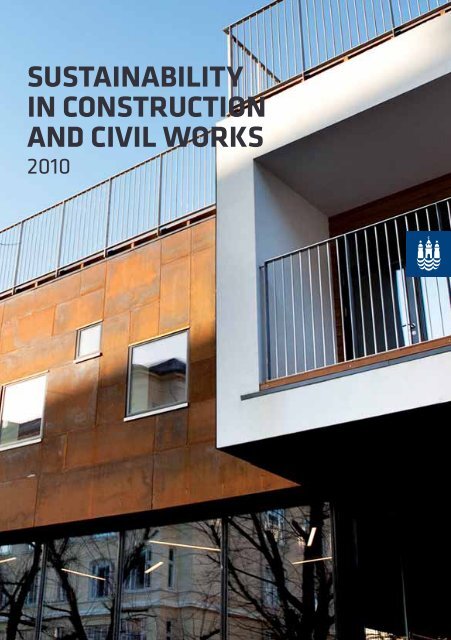
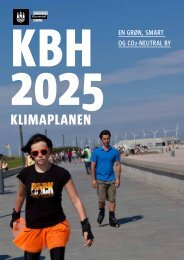
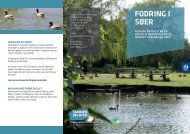
![Lokalplan 301[1] - Itera](https://img.yumpu.com/49288321/1/184x260/lokalplan-3011-itera.jpg?quality=85)
